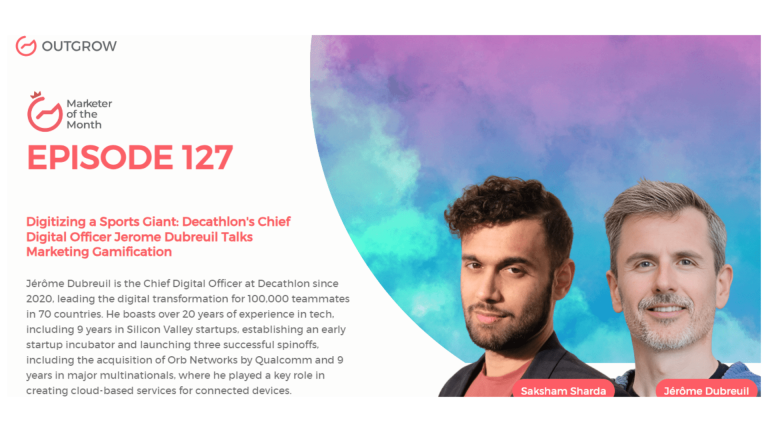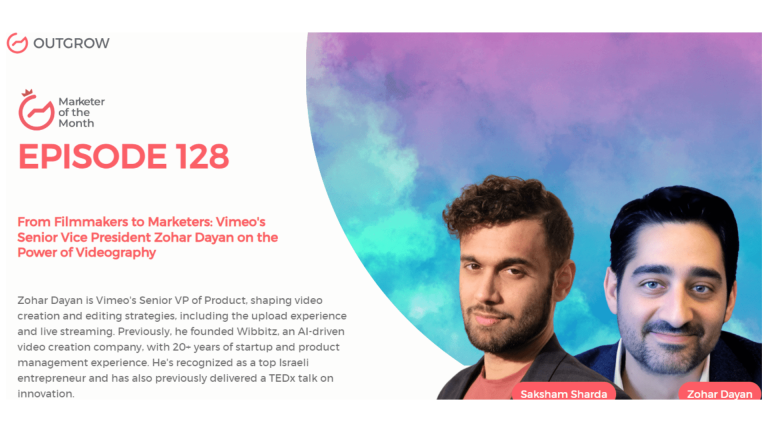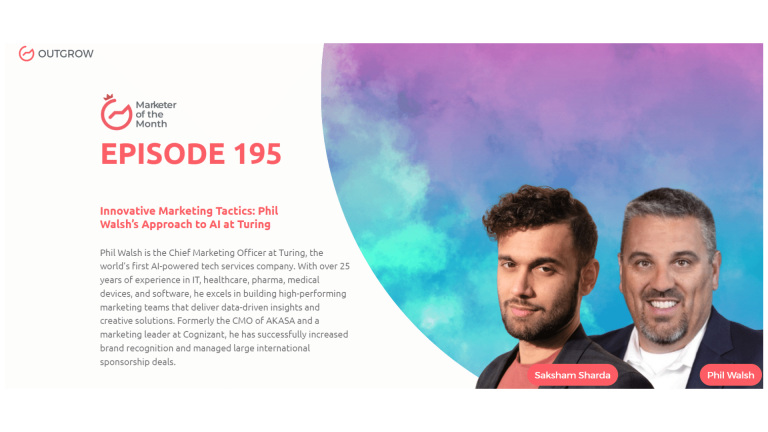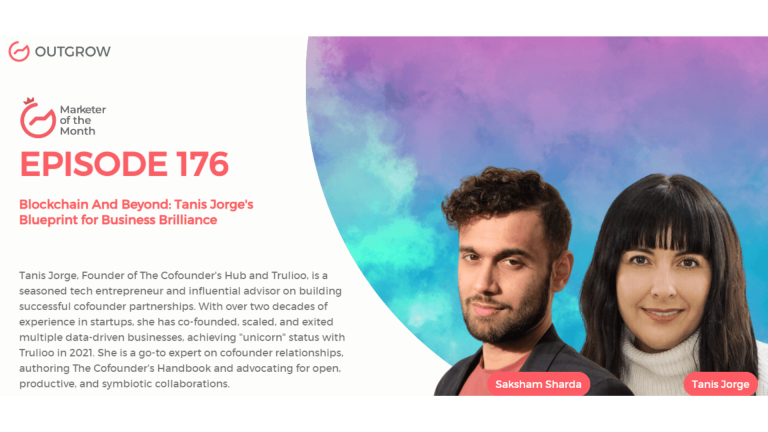EPISODE 155: Marketer of the Month Podcast with Massimiliano Mesenasco
Table of Contents
Hey there! Welcome to the Marketer Of The Month blog!
We recently interviewed Massimiliano Mesenasco for our monthly podcast – ‘Marketer of the Month’! We had some amazing insightful conversations with Massimiliano and here’s what we discussed about-
1. Navigating the complexities of MPN expansion
2. Contrasting market realities in Southern and Northern Europe
3. Varied background’s influence on strategy
4. Balancing short-term goals with long-term vision
5. Integration of cutting-edge technologies in telecom
6. Agile project management and adaptability in telecom innovation
About our host:
Dr. Saksham Sharda is the Chief Information Officer at Outgrow.co. He specializes in data collection, analysis, filtering, and transfer by means of widgets and applets. Interactive, cultural, and trending widgets designed by him have been featured on TrendHunter, Alibaba, ProductHunt, New York Marketing Association, FactoryBerlin, Digimarcon Silicon Valley, and at The European Affiliate Summit.
About our guest:
Massimiliano Mesenasco, Vodafone Business’ Southern Europe Business Development Manager, drives Mobile Private Network growth. With expertise in sales, marketing, and digital innovation, he launched Vodafone Business Videoanalysis. Passionate about sustainable tech for mobility solutions, he discusses data monetization and private networks at events.
South vs North: Vodafone’s BDM Massimiliano Mesenasco on the Spectrum Split in Europe’s Evolving Ecosystem
The Intro!
Saksham Sharda: Hi, everyone. Welcome to another episode of Outgrow’s Marketer of the Month. I’m your host, Dr. Saksham Sharda, and I’m the creative director at Outgrow. co. And for this month we are going to interview Massimiliano Mesenasco, who is the Business Development Manager at Vodafone Business.
Massimiliano Mesenasco: Great to be here. Thank you.
Don’t have time to read? No problem, just watch the Podcast!
Or you can just listen to it on Spotify!
<
The Rapid Fire Round!
Saksham Sharda: All right. So let’s start with the rapid-fire round. The first one is, at what age do you want to retire?
Massimiliano Mesenasco: I want to retire at least 65.
Saksham Sharda: How long does it take you to get ready in the mornings?
Massimiliano Mesenasco: Half an hour max.
Saksham Sharda: Most embarrassing moment of your life?
Massimiliano Mesenasco: It has to do with alcohol.
Saksham Sharda: Favorite color?
Massimiliano Mesenasco: Black.
Saksham Sharda: What time of day are you most inspired?
Massimiliano Mesenasco: In the evening after 8:00 PM.
Saksham Sharda: How many hours of sleep can you survive on?
Massimiliano Mesenasco: Seven, not less.
Saksham Sharda: Fill in the blank. An upcoming telecommunication trend is _____
Massimiliano Mesenasco: Mobile private networks.
Saksham Sharda: The city in which the best kiss of your life happened.
Massimiliano Mesenasco: Milan.
Saksham Sharda: Pick one, Elon Musk or Mark Zuckerberg.
Massimiliano Mesenasco: Mark.
Saksham Sharda: The biggest mistake of your career?
Massimiliano Mesenasco: I hoped too much through different jobs.
Saksham Sharda: How do you relax?
Massimiliano Mesenasco: I take a bicycle ride.
Saksham Sharda: How many cups of coffee do you drink per day?
Massimiliano Mesenasco: Italian coffee, four.
Saksham Sharda: A habit of yours that you hate?
Massimiliano Mesenasco: I’m not sure I pass.
Saksham Sharda: The most valuable skill you’ve learned in life?
Massimiliano Mesenasco: Be flexible.
Saksham Sharda: Your favorite Netflix show.
Massimiliano Mesenasco: It’s working moms.
Saksham Sharda: One-word description of your leadership style.
Massimiliano Mesenasco: Supportive.
Saksham Sharda: The top priority in your daily schedule.
Massimiliano Mesenasco: Not sure, pass.
Saksham Sharda: Ideal vacation spot.
Massimiliano Mesenasco: An art city.
Saksham Sharda: A key factor for maintaining a work-life balance.
Massimiliano Mesenasco: You need to exercise.
Saksham Sharda: Memorable career milestone.
Massimiliano Mesenasco: My second job was managing a sales account team in a startup.
Saksham Sharda: A recent business innovation that caught your attention.
Massimiliano Mesenasco: Gen AI.
Saksham Sharda: The last song you’ve been listening to.
Massimiliano Mesenasco: More than a feeling from Boston.
Saksham Sharda: And the last movie that you saw that had a good impression on you.
Massimiliano Mesenasco: Commandant is an Italian movie that’s out right now in the cinemas.
The Big Questions!
Saksham Sharda: Alright. Well, that was the end of the rapid fire. Cool. Now we can go into the longer questions, which you can answer with as much time and ease as you’d like. As a business development manager focusing on Vodafone business, how do you navigate the expansion of the mobile private network, and MPN business across various countries, and what obstacles have you faced in this?
Massimiliano Mesenasco: Well, you know, it’s a very good question because right now there are a lot of complexities in the private networks and five G markets in general because, in my opinion, we still lack uniformity in the roles for spectrum across different countries. So, I’m working in Southern Europe, but, even though it’s quite a homogeneous market in terms of customer needs and so on, I still find a lot of obstacles from the regulatory and in general technological complexity standpoint. But well, I believe that MPN has a lot of potential and once we are able, the industry, not just our company, will be able to provide a homogeneous solution between different countries to enterprise customers, that’s when the market will boom.
Saksham Sharda: How does it differ from the Northern European market? What are the particular complexities of the Southern European market?
Massimiliano Mesenasco: Well, the Southern European markets are, are, very fragmented. They are usually considered similar markets because, you know, Spain, and Italy, they’re considered quite similar. But actually, the regulations for the use of the five G spectrum differ. They differ quite significantly from one country to another. In other countries we work in, like Germany in the UK there is for instance, what is called the industrial spectrum. So you have this spectrum that customers can apply for to the government. They can use it independently, and I think that’s helping the market a bit. But of course, it’s also a risk. So we’ll need to see in the future where the industrial spectrum will lead because if Five G becomes another wifi with a lot of deregulation, this will be a failure.
Saksham Sharda: How does your wide-ranging background in sales and marketing across different sectors influence your approach to innovating and strategizing for initiatives in mobility and connectivity?
Massimiliano Mesenasco: Well, I have a very varied background because I’ve worked in tech startups. I work in the automotive industry. I worked in telcos before Vodafone. And this is helping me quite a lot in adapting to the needs, the actual business model, and the use cases of the customers. I think that I don’t feel like I’m a telco guy. I’m not into telco-related technology. When I’m asked about which platforms we use for data monetization and all those other very telco-specific topics, I’m not really into that. However, I feel that my value in this role and this company right now is to be an advocate for the customer. Whenever we talk about a customer in consumer services tech, in automotive, I can understand what they need and how we can deliver value to them.
Saksham Sharda: And so, considering all this experience, what are some common principles or strategies that you’ve tried to apply in this field?
Massimiliano Mesenasco: Well, the common strategy is always to get, to try at least, I don’t want to be overconfident here, but to try and get into the customer’s shoes. My first moment when I say no, to any solution that we are about to propose, to a customer is whenever there is anything, even something that we don’t sell ourselves that is more efficient, cheaper, and that can deliver the same value. I mean, that’s the first thing in the morning when I wake up. Are we delivering some solutions that are, well, an overkill that is not that efficient? Because if the customer, today we are in 2023, there’s the internet, there are analysts and so on, if there’s something which is cheaper, more efficient than what we are proposing, the customer will find out and it’ll not be good for us as I’m speaking about reputation here. So that’s the first thing we need to consider.
Saksham Sharda: So, managing teams, P&Ls, and multimillion-euro projects requires strategic foresight. How do you balance the short-term goals with the long-term vision, especially concerning the future of mobility and connectivity?
Massimiliano Mesenasco: Well, this is not always easy, but I try to split my point of view quite evenly. And most of all, I try to pick my battles and focus on what will deliver value in the future. I mean, if you ask me for my priorities, for me, priority number one is what will deliver value to our company in 2, 3, 4, or 5 years. Because we have sales teams that are focused on the short term, of course, I need to support them, and I’m supporting them there, in their job, and my job. However, my role requires me to focus on what will deliver value five years from now. And it’s not always that easy, and sometimes it’s colliding with short-term value.
Saksham Sharda: And in all this, how crucial is the consideration of cutting-edge technologies like AI, machine learning, or blockchain in achieving both these immediate goals and long-term visions?
Massimiliano Mesenasco: Well, this is something that we need to realize, I believe, as an industry, that if we don’t leverage those enablers, someone else will do that. And someone else, some younger companies, some smarter companies will come into our markets because we have entry barriers for incoming players, but they are not always that high. And someone can overcome them. And at some point, if this someone can leverage all those technologies, they will be far smarter, far more efficient than us, and they will outrank us.
Saksham Sharda: So how easy is it for big companies to be agile or flexible when it comes to new technologies in general?
Massimiliano Mesenasco: Well, we know that it’s not always easy. Being a well-established company means having structures, having a lot of people having best practices that are layered and built over years with the Italian operating company, we have more than 20 years of experience from the first, the acquisition of Tel, which was one of the first, which was the second mobile service provider in Italy. So it’s quite an old company, and it’s not always as I was saying, easy, but of course we need to fight every day to make things happen.
Saksham Sharda: So given your experience in agile project management, how has this methodology influenced your approach to leading projects, especially in industries where innovation and adaptability are crucial?
Massimiliano Mesenasco: Well, first of all, I learned that Agile may be a bit less, but there was a time when Agile was a buzzword that was everywhere in the industry. And well, just to cut it short, it helped me to be flexible and to be customer-oriented. So, particularly a tool methodology that I loved, and I learned it while working at a design company, which is part of the Volkswagen group in my automotive days, is design thinking. Design thinking brings you closer to the customer’s needs. And I think it’s something that even more than agile needs to be applied by any company, of course, any company that wants to be close to the customer, which wants to be customer-driven.
Saksham Sharda: So both design and Agile principles, in what ways do they help drive innovation without compromising project timelines or quality, especially when dealing with rapidly evolving technologies
Massimiliano Mesenasco: Well first of all we need to understand when agile can be applied and when agile cannot be applied, because sometimes having worked in different industries I always heard Agile being repeated by project managers like 10 times a day. Like they’re paid to repeat 10 times per day, the word agile. But we should be focused. We should use our knowledge, our professional knowledge, our experience, and our skills to understand when agile must be applied, and when it’s better to go for not old-fashioned ways, but other ways.
Saksham Sharda: So, with your expertise in digital innovation, how do you foresee the role of emerging technologies like AI or a complex trajectory of MPN offerings in the telecom industry in the next decade?
Massimiliano Mesenasco: Well, this is quite a complex question, but I see first of all when we are talking about it we have to consider that Vodafone is currently holding a leading position in the IoT market. Therefore, a lot of our customers in their Vodafone journey are coming from our services, IoT connectivity in particular. So mobile private networks are something that must be an integral part of our IoT connectivity offering. So if a customer today has sims in their devices, those devices must be able to roam inside and outside of a mobile private network that is built for specific use cases. So this is something that is absolutely of utmost importance. And more in general private networks, if we talk about the opposite of AI mobile private networks can draw a lot of benefits from AI, particularly in terms of well backend. So implementing an MPN provides reports on how this NPN is working, optimizing the traffic patterns. And this is something that today is not there yet, but this is something that the industry should work on.
Saksham Sharda: And then, regarding privacy and security aspects, how do you foresee the integration of AI and IoT within MPN solutions addressing potential concerns about all this?
Massimiliano Mesenasco: Well of course, when we talk about MPN we talk about customers that are of course worried about privacy and security aspects. For instance, MPN is considered critical infrastructure for some customers, particularly the ones in manufacturing, oil, gas, and so on, and whatever infrastructure that is considered critical right now is separated from the business as usual, from the office, it from the collaboration infrastructure. Because of course, if my infrastructure for the office, goes down maybe I lose half a day of working if in the offices, if my critical infrastructure, if my mobile private network goes down for you know six hours, six hours, I have a lot of customers that can tell you easily six hour correspond of production. So in manufacturing, a plant corresponds to 6 million. My plant is making 1 million per hour. So the result is that well, this situation, it is neither bad nor good will slow down the adoption of new technologies related to mobile private networks because the point of view sometimes of the customer is that the more secure, the more disconnected from the rest of the world, we are the more secure, the more secure we are. So ultimately these will slow down quite a lot of the adoption of those emerging technologies in the NPN market.
Saksham Sharda: And so how does one reach a fine balance between this concern and the other?
Massimiliano Mesenasco: Well, of course, this balance can only be found by starting. We need to start from somewhere. And particularly what I’m trying to do right now is to prove to customers that there are institutions, and organizations as concerned as they are about security and privacy that are currently adopting specific technologies on top of a mobile private network. And I’m talking about the military, I’m talking about government organizations that, as you can imagine, are very concerned about security, even national security aspects. But sometimes those organizations, that may be in the public discussion that might be perceived as slow old, are driving the adoption of those new technologies.
Saksham Sharda: So could you provide any memorable example of how AI or IoT integration might revolutionize specific aspects of MPN offerings that you’ve seen or that you’re working on that you expect to happen?
Massimiliano Mesenasco: Well, there is one example that is very close to my, to my daily business. That is IoT connectivity for cars. For years in this industry, I worked on IoT connectivity and I provided IOT connectivity for car manufacturers. And car manufacturers have hundreds of thousands of vehicles that are on the road. And they keep track of those vehicles. I mean, they’re not tracking them, but for them, it’s a live vehicle. Just because they have an IoT SIM inside these IoT SIMs inside can be easily integrated with a mobile private network that is implemented in the manufacturing plant where the car is built. So these IOT SIMs can become MPN SIMs when the car is being built. So you can download the car software in the future, and you can also have MPN at dealerships and service centers workshops. So every time a car comes into your dealership, your workshop for a repair, or a check, you can connect this car to an MPN and have secure access to this car. You can have guaranteed performances that can enable you to do system updates, check the status of the car, electronics mechanics, whatever. So this is the closest example I can provide.
Saksham Sharda: So in this fast-changing environment with innovation and all of these platforms that you’re talking about, what are the key metrics of performance indicators that you prioritize when measuring success in your projects or initiatives?
Massimiliano Mesenasco: Well, my one, and well, at the moment, the main metric is the actual adoption of the networks that we are implementing because right now we are in a situation in the MPN market where we still have a lot of proof of concepts that are good already because they start to get the ball rolling. And they’re useful for customers to get familiar with the technology. But normally proof of concept means that the customer connects one device, two devices, 10 devices, and not for critical use cases. So the more sim cards, the more devices I see connected to a mobile private network the happier I am, because this means that the customer is transitioning from a proof, an actual proof of concept to a production solution. And this is ultimately the most meaningful indicator for us as a service provider. But for the industry in general, when we talk about the adoption of 5G.
Saksham Sharda: So do you have an example of a project where you successfully aligned customer value with other interests? Which specific KPIs played a pivotal role in measuring the success of the initiative?
Massimiliano Mesenasco: Well, we have several examples. For instance, one in Italy was released to the press just a few days ago. It’s about the mobile private networks that we are building for Snam. It’s a mobile private well, Snam is the National Gas Company in Italy. So they own the whole natural gas distribution network. Their infrastructure is built off of more than 20 sites, which are part of the national strategic infrastructure of Italy, of course. In this case, we were required to build a private network, which was well, not far from our product portfolio, our product standards, and what we can call them. But of course, the customer had a lot of very specific, specific requirements. And in this case, we’ve been, and I can say that the Italian operating company, Vodafone, Italy, has been you know send, how can I say? They have been smart enough to have the right level of engagement for their management. The right people were involved immediately in the project. Now, I will not talk specifically about KPIs, but I will just say that right now, our best salespeople are the colleagues, the partners from Snam itself that are presenting this with pride, this solution to conferences, meeting things with other customers, and public technology events. So probably the customer right now spoke with the media much more about this solution. Well, much more than we did.
Saksham Sharda: So let’s pivot a little to 5G. What are some of the barriers to the adoption of private 5G, and what is the role of telcos in lowering these barriers, do you think?
Massimiliano Mesenasco: Well as a telco, you know, we see the whole value chain, because we have been deploying five G since its inception and even before its inception, we worked with regulators and organizations to define this very standard. We worked with technology vendors like Nokia, like Ericsson, and Huawei, to define how the five G would’ve been. And right now, what do we see on the market? Is that a second?
Saksham Sharda: Could you repeat what we see in the market from there?
Massimiliano Mesenasco: Right now, what we are seeing in the market is that there are a lot of players, particularly in markets where there is an industrial five G spectrum available proposing five G private networks. But customers are still struggling to find value. Well, of course not all of them, but some of them. And some of those customers would like to, how can I say, start small if you need, based on the industrial spectrum to build an actual private network from the grounds up, you cannot start small. But some players are the telcos that have a live five G infrastructure. And of course, with the right for the right use case for the right perimeter, what telcos can do is provide customers with a, a low effort low cost, but highly efficient solution based on public networks that can provide them at least the first glance of what a private mobile private network is on the five G standard, and can pave the way for either a growth, so they can start from a shared infrastructure and then deploy a private one. Or they can just stick to the shared infrastructure and build their automation industry with four zero use cases on these very infrastructures where they started from.
Saksham Sharda: And are there any specific industries or sectors where the barriers to adopting private 5G networks are much higher?
Massimiliano Mesenasco: Well of course the barriers are higher. The less the need for the performance of five G is perceived. I have several customers you know less, how can I say that? Less technology-heavy verticals like, I don’t know, they are manufacturing basic glass products or they are just manufacturing construction materials. And you know, in those verticals where automation is less present, of course, the need is far lower. They are okay with wifi. They are okay with other wireless technologies. And therefore for these kinds of customers to, well, to get into those market segments, what we need to do, what the industry we need to do is to lower the total cost of ownership of five G solutions.
Saksham Sharda: So are there any skill gaps or expertise needed for operating private 5G networks? And are telcos supporting businesses in training and up-skilling their workforce to do this?
Massimiliano Mesenasco: Well, you know, for me, I think this is, there are two, two aspects to this question. Of course on the telco side deploying mobile networks without specifying if they’re private or public, it’s something that we have done since we were born, as companies. So one thing that is very interesting for us is that this is one of those new technologies where we are extremely skilled. I mean, while maybe system integrators start with the private networks business, they have to upskill their entire workforce, or at least the part of the workforce that will work on this business. We have hundreds of people in our company who are very well aware of all the technicalities of mobile networks, regardless of whether they are private or public. Of course, there will be some little upskilling to be done, for the private part, and we did that. But we are in a very lucky position. A different well, it’s quite different for end customers, because end customers right now, they’re used for their networking solution to at least to a certain extent to directly work on network elements, to work on switches, to work on access points on routers and so on. With mobile networks, it’s something that they are not ready to do, and that’s the reason why it’s mobile. Private networks are probably the solution where customers ask the most for a fully managed service.
Saksham Sharda: So you manage multi-million-euro projects in various industries. How did the complexities of executing such projects in the telecom sector like the MPN differ from those in other sectors like automotive or insurance?
Massimiliano Mesenasco: Well we have to consider that of course we have skilled personnel, we have skilled people working on private or public networks regardless. But of course, this is an advantage on one hand, but we also need to take into account that we have ears and ears and ears of best practices built on building public networks. And so sometimes we just realize that we need to create some discontinuity to, you know, just we have to push a little bit harder.
Saksham Sharda: Alright. So the last question for you is of a personal kind. What would you be doing in your life, if not this?
Massimiliano Mesenasco: Well, it’s a difficult question because I will not say that this is what I was dreaming of when I was a child, but this is what I started dreaming of after I started doing it. And that’s a bit of how I always lived my professional life. So right now, honestly, I cannot imagine myself in a different position, but probably if I were to be in any different position, it would still be a customer-facing role, not a sales role. But right now, I can tell you where I think I would fit. It’s still on emerging technologies. If I didn’t work on mobile private networks, I would feel quite comfortable working with Gen AI or working with IoT or any related business.
Let’s Conclude!
Saksham Sharda: Thanks, everyone for joining us for this month’s episode of Outgrow’s Marketer of the Month. That was Massimiliano Mesenasco, who is the Business Development Manager at Vodafone Business.
Massimiliano Mesenasco: Pleasure. Thanks for having me.
Saksham Sharda: Check out the website for more details and we’ll see you once again next month with another marketer of the month.

Muskan is a Marketing Analyst at Outgrow. She is working on multiple areas of marketing. On her days off though, she loves exploring new cafes, drinking coffee, and catching up with friends.









